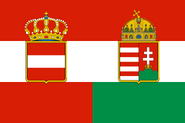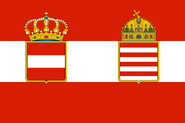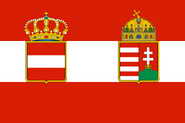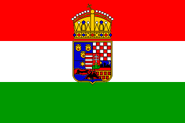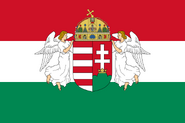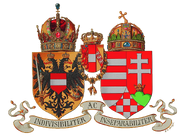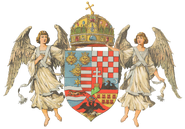| Austria-Hungary Other names Österreichisch-Ungarische Monarchie (de) Osztrák-Magyar Monarchia (hu) | ||||||||||||||||||||
| Empire | ||||||||||||||||||||
| ||||||||||||||||||||
| ||||||||||||||||||||
| Anthem None Imperial anthem Gott erhalte, Gott beschütze / Unsern Kaiser, unser Land! "God preserve, God protect / Our Emperor, our country!" | ||||||||||||||||||||
Location of the Austro-Hungarian Empire in 1913
| ||||||||||||||||||||
| Capital | Vienna & Budapest | |||||||||||||||||||
| Languages | German, Hungarian, Czech, Polish, Ukrainian, Romanian, Croatian, Slovak, Serbian, Slovene, Rusyn, Italian, Yiddish [1][2] | |||||||||||||||||||
| Religion | State: Roman Catholicism; also Protestantism, Eastern Orthodoxy, Judaism, Sunni Islam | |||||||||||||||||||
| Government | Constitutional monarchy, personal union through the Dual Monarchy | |||||||||||||||||||
| Emperor & King | ||||||||||||||||||||
| - | 1867–1916 | Francis Joseph I | ||||||||||||||||||
| - | 1916–1918 | Charles I | ||||||||||||||||||
| Minister-President | ||||||||||||||||||||
| - | 1867–1871 | Friedrich von Beust (first) | ||||||||||||||||||
| - | 1918 | Heinrich Lammasch (last) | ||||||||||||||||||
| Prime Minister | ||||||||||||||||||||
| - | 1867–1871 | Gyula Andrássy (first) | ||||||||||||||||||
| - | 1918 | János Hadik (last) | ||||||||||||||||||
| Historical era | New Imperialism | |||||||||||||||||||
| - | 1867 Compromise | 30 March 1867 | ||||||||||||||||||
| - | Czecho-Slovak indep. | 28 October 1918 | ||||||||||||||||||
| - | South Slavs indep. | 29 October 1918 | ||||||||||||||||||
| - | Dissolution | 31 October 1918 | ||||||||||||||||||
| - | Dissolution treaties¹ | in 1919 & in 1920 | ||||||||||||||||||
| Area | ||||||||||||||||||||
| - | 1914 | 676,615 km² (261,243 sq mi) | ||||||||||||||||||
| Population | ||||||||||||||||||||
| - | 1914 est. | 52,800,000 | ||||||||||||||||||
| Density | 78 /km² (202.1 /sq mi) | |||||||||||||||||||
| Currency | Gulden Krone (from 1892) | |||||||||||||||||||
| ||||||||||||||||||||
| Today part of | ||||||||||||||||||||
| 1) Treaty of Saint-Germain signed September 10, 1919 and the Treaty of Trianon signed June 4, 1920. | ||||||||||||||||||||
| Austro-Hungarian Empire | |
|---|---|
| Official Long names (and English translation thereof) | |
| en: The Kingdoms and Lands Represented in the Imperial Council and the Lands of the Holy Hungarian Crown of Saint Stephen
de: Die im Reichsrat vertretenen Königreiche und Länder und die Länder der heiligen ungarischen Stephanskrone hu: A birodalmi tanácsban képviselt királyságok és országok és a magyar Szent Korona országai |
Austria-Hungary or Austro-Hungarian Monarchy, also known as the Dual Monarchy or the k.u.k. Monarchy, was a monarchic union between the crowns of the Austrian Empire and the Kingdom of Hungary in Central Europe. The union was a result of the Ausgleich or Compromise of 1867, under which the Austrian House of Habsburg agreed to share power with the separate Hungarian government, dividing the territory of the former Austrian Empire between them. The Dual Monarchy had existed for 51 years when it dissolved on October 31, 1918 following military defeat in the First World War.
Structure and name
The Habsburg monarch ruled as Emperor of Austria[3] over the western and northern half of the country that was the Empire of Austria (Cisleithania or Lands represented in the Imperial Council)[4] and as King of Hungary[3] over the Kingdom of Hungary (Transleithania or Lands of St Stephen's Crown)[4] which enjoyed self-government and representation in joint affairs (principally foreign relations and defence).[5]
The two capitals of the Monarchy were Vienna for Austria and Budapest for Hungary.[4] Austria-Hungary was geographically the second largest country in Europe after the Russian Empire (621,538 square kilometres (239,977 sq mi) in 1905[6]), and the third most populous (after Russia and the German Empire). Today, the territory it covered has a population of about 69 million.
As a multinational empire and great power in an era of national awakening, it found its political life dominated by disputes among the eleven principal national groups.
The Monarchy bore the name internationally of "Österreichisch-Ungarische Monarchie" (on decision by Franz Joseph I in 1868), which in full meant "The Kingdoms and Lands Represented in the Imperial Council and the Lands of the Crown of St. Stephen".
Name in official languages of Austria-Hungary
Names of the Dual Monarchy in languages of its citizens officially recognized:
- Croatian: Austro-Ugarska
- Czech: Rakousko-Uhersko
- German: Österreich-Ungarn
- Hungarian: Ausztria-Magyarország
- Italian: Austria-Ungheria
- Polish: Austro-Węgry
- Romanian: Austro-Ungaria
- Serbian: Aустро-Угарска/Austro-Ugarska
- Slovak: Rakúsko-Uhorsko
- Slovene: Avstro-Ogrska
- Turkish: Avusturya-Macaristan Krallığı
- Ukrainian: Австро-Угорщина/Avstro-Uhorshchina|
Creation
| Part of a series on the |
| History of Austria |
|---|
 |
| Early History |
| Hallstatt culture |
| Noricum |
| Marcomanni |
| Samo's Realm |
| Carantania |
| March of Austria |
| Babenberger |
| Privilegium Minus |
| Habsburg era |
| House of Habsburg |
| Holy Roman Empire |
| Archduchy of Austria |
| Habsburg Monarchy |
| Austrian Empire |
| German Confederation |
| Austria-Hungary |
| World War I |
| Assassination of Franz Ferdinand |
| World War I |
| Interwar Years |
| German Austria |
| First Republic of Austria |
| Austrofascism |
| Anschluss |
| World War II |
| National Socialism |
| World War II |
| Post-war Austria |
| Allied-occupied Austria |
| Second Austrian Republic |
|
|
| Part of a series on the |
| History of Hungary |
|---|
 |
| Ancient history |
| Hungarian Prehistory |
| Middle ages |
| Medieval Hungary (896–1526) |
| Ottoman–Hungarian Wars |
| Early Modern Hungary |
| Royal Hungary |
| Principality of Transylvania |
| Ottoman Hungary (1541-1699) |
| History of Hungary 1700–1918 |
| 19th century |
| Revolution of 1848–49 |
| Compromise of 1867 |
| 20th century |
| Hungary in World War I |
| Interwar period (1918–41) |
| Hungary in World War II |
| People's Republic 1949–89 |
| Revolution of 1956 |
| 1989 – present |
| Topics in Hungarian History |
| Military history |
| History of the Székely |
| History of the Jews in Hungary |
| Music history |
| History of Transylvania |
| The Csangos |
|
|
| File:Croatia, Historic Coat of Arms.svg
This article is part of the series on the | |||

| |||
| Early History | |||
| Before the Croats | |||
| Origins of the Croats | |||
| Medieval History | |||
| Medieval Croatian state | |||
| Kingdom of Croatia | |||
| Union with Hungary | |||
| Habsburg rule | |||
| 20th century Croatia | |||
| Kingdom of Yugoslavia | |||
| Independent State of Croatia | |||
| Part of SFR Yugoslavia | |||
| Contemporary Croatia | |||
| War of independence | |||
| Republic of Croatia
| |||
The Austro-Hungarian Compromise of 1867 which inaugurated the empire's dualist structure in place of the former unitary Austrian Empire (1804–67) originated at a time when Austria had declined in strength and in power—both in the Italian Peninsula (as a result of the Austro–Sardinian War of 1859) and among the states of the German Confederation (where it had been replaced by Prussia as the dominant German-speaking power following the Austro–Prussian War of 1866). Other factors in the constitutional changes included continued Hungarian dissatisfaction with rule from Vienna and increasing national consciousness on the part of other nationalities of the Austrian Empire. Hungarian dissatisfaction grew partially from Austria's suppression, with Russian support, of the Hungarian liberal revolution of 1848–1849. However, dissatisfaction with Austrian rule had grown for many years within Hungary, and had many other causes.
By the late 1850s, however, a large number of Hungarians who had supported the 1848-49 revolution were willing to accept the Habsburg monarchy. They took the line that while Hungary had the right to full internal independence, under the Pragmatic Sanction foreign affairs and defense were "common" to both Austria and Hungary.
In the effort to shore up support for the monarchy, Emperor Franz Joseph began negotiations for a compromise with the Hungarian nobility to ensure their support. In particular, Hungarian leaders demanded and received the Emperor's coronation as King of Hungary, and the re-establishment of a separate parliament at Budapest with the powers to enact laws for the lands of the Hungarian crown.
From 1867 onwards, the abbreviations heading the names of official institutions in Austria-Hungary reflected their responsibility:
- K. u. k. (kaiserlich und königlich) or Imperial & Royal was the label for common institutions of both parts of the Monarchy, e.g. the k.u.k. Kriegsmarine (War Fleet) or, during the war, the k.u.k. Armee (Army). There were only three k.u.k. ministries:
- The Imperial & Royal Ministry of the Exterior and the Imperial House
- The Imperial & Royal War Ministry
- The Imperial & Royal Ministry of Finance (Only for military and diplomatic expenses)
The latter was only responsible for financing the Imperial & Royal household, the diplomatic service, the common army and the common war fleet. All other state functions were matters to be handled separately in each of the two states. Common agenda from 1867 onwards were sponsored by Austria with 70% and by Hungary with 30% of the total costs; this split had to be negotiated every ten years. Until 1907, the Hungarian share rose to 36.4%.[7] The negotiations in 1917 ended with the dissolution of the Dual Monarchy.
The common army changed its label from k.k. to k.u.k. only in 1889, on urgent demand of the Hungarian government.
- K. k. (kaiserlich-königlich) or Imperial-Royal was the label for institutions of Cisleithania (Austria); royal in this abbreviation meant the crown of Bohemia.
- K. u. (königlich-ungarisch), M. k. (Magyar királyi) or Royal Hungarian were the institutions of Transleithania, the lands of the Hungarian crown.
(In the media, k.u.k. is often misused for k.k. institutions.)
Politics and government
Government
Three distinct elements ruled the Austro-Hungarian Empire:
- common foreign, military and joint financial policy under the monarch
- the "Austrian" or Cisleithanian government
- the Hungarian government
Hungary and Austria maintained separate parliaments, each with its own prime minister. Linking/co-ordinating the two fell to a government under a monarch, wielding power absolute in theory but limited in practice. The monarch’s common government had responsibility for the army, for the navy, for foreign policy, and for the customs union.
Within Cisleithania and Hungary certain regions, such as Galicia and Croatia enjoyed special status with their own unique governmental structures.
A common Ministerial Council ruled the common government: it comprised the three ministers for the joint responsibilities (joint finance, military, and foreign policy), the two prime ministers, some Archdukes and the monarch. Two delegations of representatives (60–60 members), one each from the Austrian and Hungarian parliaments, met separately and voted on the expenditures of the Common Ministerial Council, giving the two governments influence in the common administration. However, the ministers ultimately answered only to the monarch, and he had the final decision on matters of foreign and military policy.
Overlapping responsibilities between the joint ministries and the ministries of the two halves caused friction and inefficiencies. The armed forces suffered particularly from overlap. Although the unified government determined overall military direction, the Austrian and Hungarian governments each remained in charge of "the quota of recruits, legislation concerning compulsory military service, transfer and provision of the armed forces, and regulation of the civic, non-military affairs of members of the armed forces". Needless to say, each government could have a strong influence over common governmental responsibilities. Each half of the Dual Monarchy proved quite prepared to disrupt common operations to advance its own interests.
Relations over the half-century after 1867 between the two halves of the Empire (in fact the Cisleithan part contained about 57% of the combined realm's population and a rather larger share of its economic resources) featured repeated disputes over shared external tariff arrangements and over the financial contribution of each government to the common treasury. Under the terms of the Austro-Hungarian Compromise of 1867, an agreement, renegotiated every ten years, determined these matters. Each build-up to the renewal of the agreement saw political turmoil. The disputes between the halves of the Empire culminated in the mid-1900s in a prolonged constitutional crisis—triggered by disagreement over the language of command in Hungarian army units, and deepened by the advent to power in Budapest (April 1906) of a Hungarian nationalist coalition. Provisional renewals of the common arrangements occurred in October 1907 and in November 1917 on the basis of the status quo.
Politics
Legally, besides the Pragmatic Sanction of 1713 there were no common laws in Austria-Hungary. All laws, even the ones with identical content like the compromise of 1867, had to pass the parliaments both in Vienna and Budapest and were published in the respective official medium (in the Austrian half it was called Reichsgesetzblatt and was issued in eight languages). To conclude on identical texts, the two parliaments elected delegations of 60 of their members each, which discussed motions of the Imperial & Royal ministries separately and tried to find a compromise.
The first prime minister of Hungary after the Compromise was Count Gyula Andrássy. The old Hungarian Constitution was restored, and Franz Joseph was crowned as King of Hungary. During this time Austria-Hungary was geographically the second largest country in Europe after the Russian Empire (621,537 square kilometres (239,977 sq mi)), and the third most populous (after Russia and the German Empire).
The Empire relied increasingly on a cosmopolitan bureaucracy - in which Czechs played an important role - backed by loyal elements, including a large part of the German, Hungarian, Polish and Croat aristocracy.[8]
Foreign policy
By the late 1860s, Austrian ambitions in both Italy and Germany had been choked off by the rise of new national powers. With the decline and failed reforms of the Ottoman Empire, Slavic opposition in the occupied Balkans grew and both Russia and Austria-Hungary saw an opportunity to expand in this region. In 1876, Russia offered to partition the Balkans, but Andrássy declined for Austria-Hungary was already a "saturated" state and it could not cope with additional territories.[9] The whole monarchy was thus drawn into a new style of diplomatic brinkmanship, first conceived of by Andrássy, centering on the province of Bosnia and Herzegovina, a predominantly Slavic area of the Ottoman Empire, which was transferred to Austro-Hungarian control in 1878 by the Congress of Berlin. It was a dangerous game to play in a dangerous place. A road was thus mapped out, with a terminus at Sarajevo in 1914.
Economy

A twenty-crown banknote of the Dual Monarchy
The Austro-Hungarian economy changed dramatically during the existence of the Dual Monarchy. The capitalist way of production spread throughout the Empire during its 50-year existence replacing medieval institutions. Technological change accelerated industrialization and urbanization. The GNP per capita grew roughly 1.76 percent per year from 1870 to 1913. That level of growth compared very favorably to that of other European nations such as Britain (1.00 percent), France (1.06 percent), and Germany (1.51 percent).[10] However, in a comparison with Germany and Britain: the Austro-Hungarian economy as a whole still lagged considerably, as sustained modernization had begun much later. In 1873, the old capital Buda and Óbuda (Ancient Buda) were officially merged with the third city, Pest, thus creating the new metropolis of Budapest. The dynamic Pest grew into Hungary's administrative, political, economic, trade and cultural hub. Many of the state institutions and the modern administrative system of Hungary were established during this period. Economic growth centered on Vienna and Budapest, the Austrian lands (areas of modern Austria), the Alpine region and the Bohemian lands. In the later years of the 19 century, rapid economic growth spread to the central Hungarian plain and to the Carpathian lands. As a result, wide disparities of development existed within the Empire. In general, the western areas became more developed than the eastern.
However, by the end of the 19th century, economic differences gradually began to even out as economic growth in the eastern parts of the Empire consistently surpassed that in the western. The strong agriculture and food industry of the Kingdom of Hungary with the center of Budapest became predominant within the Empire and made up a large proportion of the export to the rest of Europe. Meanwhile, western areas, concentrated mainly around Prague and Vienna, excelled in various manufacturing industries. This division of labour between the east and west, besides the existing economic and monetary union, led to rapid economic growth throughout Austria-Hungary by the early 20th century.
Rail transport expanded rapidly in the Austro-Hungarian Empire. Its predecessor state, the Habsburg Empire, had built a substantial core of railways in the west, originating from Vienna, by 1841. At that point, the government realized the military possibilities of rail and began to invest heavily in construction. Preßburg (Bratislava), Budapest, Prague, Kraków, Graz, Laibach (Ljubljana) and Venedig (Venice) became linked to the main network. By 1854, the empire had almost 2,000 kilometres of track, about 60 to 70 percent of it in state hands. The government then began to sell off large portions of track to private investors to recoup some of its investments and because of the financial strains of the 1848 Revolution and of the Crimean War.
From 1854 to 1879, private interests conducted almost all rail construction. What would become Cisleithania gained 7,952 track kilometres, and Hungary built 5,839 track kilometres. During this time, many new areas joined the railway system and the existing rail networks gained connections and interconnections. This period marked the beginning of widespread rail transportation in Austria-Hungary, and also the integration of transportation systems in the area. Railways allowed the Empire to integrate its economy far more than previously possible, when transportation depended on rivers.
After 1879, the Austro-Hungarian government slowly began to renationalize the rail network, largely because of the sluggish pace of development during the worldwide depression of the 1870s. Between 1879 and 1900, more than 25,000 km of railways were built in Cisleithania and Hungary. Most of this constituted "filling in" of the existing network, although some areas, primarily in the far east, gained rail connections for the first time. The railway reduced transportation costs throughout the Empire, opening new markets for products from other lands of the Dual Monarchy. See Imperial Austrian State Railways for details.
Ethnic relations
- For the conceived plan for the federalization of Austria-Hungary, see United States of Greater Austria.
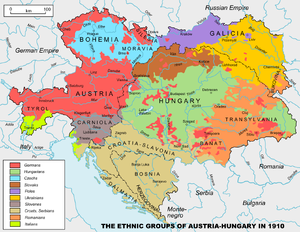
Ethnic map of Austria-Hungary, 1910 census
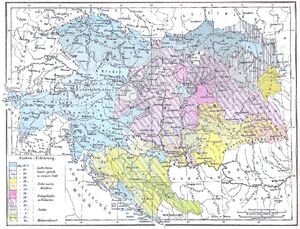
Religions in Austria-Hungary, from the 1881 edition of Andrees Allgemeiner Handatlas. Catholics (both Roman and Uniate) are blue, Protestants purple, Eastern Orthodox yellow, and Muslims green.
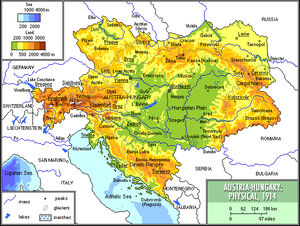
Austria-Hungary 1914, physical
In July 1849 the Hungarian Revolutionary Parliament proclaimed and enacted the first laws of ethnic and minority rights in the world (The second was in Switzerland). However this law ceased to exist after The army of the Russian Czar and Austrian Emperor crushed the Hungarian Revolution.
The Austro-Hungarian Compromise of 1867, in creating a semi-independent Hungary, entailed the rise of an assertive Magyar identity within the Kingdom of Hungary. The Romanian and Slav minorities resented the rise of a government-sponsored Magyar (ethnic Hungarian) nationalism, perceived as less liberal in language and cultural matters than the policies previously set by Vienna. Nationalistic ideas prevalent in the Empire of Austria created tension between ethnic German and Czech citizens, too. In addition, the emergence of national identity in newly independent Romania and Serbia also contributed to the ethnic issues of the empire.
Article 19 of the 1867 "Basic State Act" (Staatsgrundgesetz), valid only for the Cisleithanian (Austrian) part of Austria-Hungary,[11] says:
All races of the empire have equal rights, and every race has an inviolable right to the preservation and use of its own nationality and language. The equality of all customary languages ("landesübliche Sprache") in school, office and public life, is recognized by the state. In those territories in which several races dwell, the public and educational institutions are to be so arranged that, without applying compulsion to learn a second country language ("Landessprache"), each of the races receives the necessary means of education in its own language.
The implementation of this principle led to several disputes since everything depended on the decision as to which language could be regarded as landesüblich or customary. The Germans, the traditional bureaucratic, capitalist and cultural elite, demanded the recognition of their language as a customary language in every part of the Empire. While Italian was regarded as an old "culture language" (Kultursprache) by German-speaking intellectuals and had always been granted equal rights as an official language of the Empire, they had particular difficulties in accepting the Slavic languages as equal to German. On one occasion Count A. Auersperg (Anastasius Grün) entered the diet of Carniola carrying what he claimed to be the whole corpus of Slovene literature under his arm to provide evidence that the Slovene language could in his view not be substituted for German as a medium of higher education.
Nevertheless the following years saw an emancipation of several languages at least in the Cisleithanian part of the Empire. In a series of laws from 1867 and onwards, the Croatian language was raised to equality with the hitherto officially dominating Italian language in Dalmatia. From 1882 there was a Slovene majority in the diet of Carniola and in the capital Laibach (Ljubljana), thereby replacing German as the dominant official language. Polish was introduced instead of German in 1869 in Galicia as the normal language of government. The Poles themselves systematically disregarded the large Ukrainian minority in the country, and Ukrainian was not granted the status of an official language.
The language disputes were most fiercely fought in Bohemia where the Czechs formed a majority and wanted to reestablish the equal status for their language. German speakers lost their majority in the Bohemian diet in 1880 and their dominating position in the cities of Prague and Pilsen (while retaining a slight numerical majority in the city of Brno (Brünn)) and found themselves in an unfamiliar minority position. The old Charles University in Prague hitherto dominated by the German speakers was divided into a German and a Czech part in 1882.
At the same time, Hungarian dominance faced challenges from the local majorities of Romanians in Transylvania and in the eastern Banat, of Slovaks in today's Slovakia, of Croats and Serbs in the crownlands of Croatia and of Dalmatia (today's Croatia), in Bosnia and Herzegovina and in the provinces known as the Vojvodina (today's northern Serbia). The Romanians and the Serbs also looked to union with their fellow nationalists in the newly-founded states of Romania (1859–78) and Serbia.
Though Hungary's leaders showed on the whole less willingness than their Austrian counterparts to share power with their subject minorities, they granted a large measure of autonomy to the Croatia in 1868, paralleling to some extent their own accommodation within the Empire the previous year. The Croatian government, in spite of nominal autonomy, was in fact an economic and administrative arm of Hungary, which the Croatians resented.
Language was one of the most contentious questions in Austro-Hungarian politics. All governments faced difficult and divisive hurdles in sorting out the languages of government and of instruction. Minorities wanted to ensure the widest possibility for education in their own language as well as in the "dominant" languages of Hungarian and German. On one notable occasion, that of the so-called "Ordinance of April 5, 1897", the Austrian Prime Minister Kasimir Felix Graf Badeni gave Czech equal standing with German in the internal government of Bohemia, leading to a crisis because of nationalist German agitation throughout the Empire. In the end Badeni was dismissed.
The Hungarian minority act from 1868 gave the minorities (Slovaks, Romanians, Serbs etc.) individual (and not also community) rights to use their language in offices, schools (although in practice often only in those founded by them and not by the state), at courts and in municipalities (if 20% of the deputies demanded it). From June 1907 (lex Apponyi) all the public and private schools in Hungary were obliged to teach the Hungarian language to such an extent that after the fourth grade the pupils could express themselves fluently in Hungarian, which led to the closing of several minority schools, mostly Slovak and Rusyn.
It was not rare for the two kingdoms to divide spheres of influence. According to Misha Glenny (The Balkans, 1804–1999), the Austrians responded to Hungarian badgering of Czechs by supporting the Croatian national movement in Zagreb.
Emperor Franz Joseph himself was very well aware that he reigned in a multiethnic country and spoke German, Hungarian and Czech fluently, Polish and Italian to some degree.
The situation of Jews in the kingdom, who numbered about 2 million in 1914, was ambiguous. Antisemitic parties and movements existed, but Vienna did not initiate pogroms or implement official antisemitic policies. This was mainly out of fear that such ethnic violence could ignite other ethnic minorities and result in violence that could spin out of control. The majority of Jews lived in small towns in Galicia and rural areas in Hungary and Bohemia, although there were large communities in Vienna, Budapest, Prague and other large cities.
Linguistic distribution
| Linguistic distribution of Austria–Hungary | |
|---|---|
| German | 24% |
| Hungarian | 20% |
| Czech | 13% |
| Polish | 10% |
| Ruthenian | 8% |
| Romanian | 6% |
| Croat | 5% |
| Slovak | 4% |
| Serb | 4% |
| Slovene | 3% |
| Italian | 3% |
| Land | Most common language | Other languages (more than 2%) | ||||||
|---|---|---|---|---|---|---|---|---|
| Bohemia | 63.2% | Czech | 36.8% | German | ||||
| Dalmatia | 96.2% | Croatian | 2.8% | Italian | ||||
| Galicia | 58.6% | Polish | 40.2% | Ukrainian | ||||
| Lower Austria | 95.9% | German | 3.8% | Czech | ||||
| Upper Austria | 99.7% | German | ||||||
| Bukovina | 38.4% | Ukrainian | 34.4% | Romanian | 21.2% | German | 4.6% | Polish |
| Carinthia | 78.6% | German | 21,2% | Slovene | ||||
| Carniola | 94.4% | Slovene | 5.4% | German | ||||
| Salzburg | 99.7% | German | ||||||
| Silesia | 43.9% | German | 31.7% | Polish | 24.3% | Czech | ||
| Styria | 70.5% | German | 29.4% | Slovene | ||||
| Moravia | 71.8% | Czech | 27.6% | German | ||||
| Tyrol | 57.3% | German | 42.1% | Italian | ||||
| Küstenland | 37.3% | Slovene | 34.5% | Italian | 24.4% | Croatian | 2.5% | German |
| Vorarlberg | 95.4% | German | 4.4% | Italian | ||||
Note that some languages are considered dialects of more widely-spoken languages. For example, Rusyn and Ukrainian were both counted as "Ruthenian" in the census, and Rhaeto-Romance languages were counted as "Italian".
World War I
Preludes: Bosnia and Herzegovina
On the heels of the Great Balkan Crisis, Austro-Hungarian forces occupied Bosnia and Herzegovina in August 1878 and the monarchy eventually annexed Bosnia and Herzegovina in October 1908 as a common holding under the control of the I. & R. finance ministry, rather than attaching it to either territorial government. The occupation of Bosnia-Herzegovina was a step taken in return for Russia's advances into Bessarabia. Unable to mediate between Turkey and Russia over the control of Serbia, Austria-Hungary declared neutrality when the conflict between the two powers escalated into a war.[9] At the Congress of Berlin in 1878, Andrássy managed to force Russia to retreat from further demands in the Balkans. As a result, Great Bulgaria was broken up and Serbian independence was guaranteed.[9] In order to counter Russian and French interests in Europe, Austria-Hungary concluded an alliance with Germany in October 1879 and with Italy in May 1882.
The annexation in 1908 led some in Vienna to contemplate combining Bosnia and Herzegovina (originally Bosnien und Herzegowina) with Croatia to form a third, slavic component of the Empire. The deaths of Franz Joseph's brother, Maximilian (1867), and only son, Rudolf, made the Emperor's nephew, Franz Ferdinand, heir to the throne. The archduke was said to have been an advocate for this trialism, by which he wanted to limit the power of the Magyar aristocracy. As a result of these rumors Franz Ferdinand was not loved either in Hungary or in Serbia.
Decision for war
On June 28, 1914, Franz Ferdinand visited the Bosnian capital, Sarajevo, where Bosnian Serb militants of the nationalist group Mlada Bosna, supplied by the Serbian militant group Black Hand, ambushed his convoy and assassinated him. There were several members of the Black Hand in Sarajevo that day. Before Franz was shot, somebody had already tried to kill him and his wife. A member of the Black Hand threw a grenade at the car, but missed. It injured some people nearby and Franz Ferdinand made sure they were given medical attention before the convoy could carry on. Gavrilo Princip was the man who shot and killed Franz Ferdinand and his wife Sophie. The convoy took a wrong turn into a street where Gavrilo Princip was. He took out a pistol from his pocket and shot Franz and his wife.
The Empire's military spending had not even doubled since the 1878 Congress of Berlin, while German spending had risen fivefold, and British, Russian, and French threefold. The Empire had previously lost ethnically Italian areas to Piedmont owing to nationalist movements sweeping through Italy, and many Austro-Hungarians perceived the threat of losing the southern territories inhabited by Slavs to Serbia as imminent. Serbia had recently gained a significant amount of territory in the Second Balkan War of 1913, causing much distress in government circles in Vienna and Budapest.
Some members of the government, such as Conrad von Hötzendorf, had wanted to confront the resurgent Serbian nation for some years in a preventive war, which was disliked by the emperor, 84 years old and enemy of all adventures. But the leaders of Austria-Hungary, especially Count Leopold von Berchtold, backed by its ally Germany, decided to confront Serbia militarily before it could incite a revolt; using the assassination as an excuse, they presented a list of ten demands called the July Ultimatum,[13] expecting Serbia would never accept. When Serbia accepted nine of the ten demands but only partially accepted the remaining one, Austria-Hungary declared war. Franz Joseph I in the end had followed the urgent suggestions of his top advisors.
Over the course of July and August 1914, these events caused the start of World War I, as Russia mobilized in support of Serbia, setting off a series of countermobilizations. Italy initially remained neutral, although it had an alliance with Austria-Hungary. In 1915, it switched to the side of the Entente powers, hoping to gain territory from its former ally.
Main events
General Franz Conrad von Hötzendorf was the Chief of the Austro-Hungarian General Staff. Franz Joseph I, feeling himself much too old to command the army, made archduke Friedrich von Österreich-Teschen Supreme Army Commander (Armeeoberkommandant), but asked him to give general Conrad any freedom to take decisions. Under Conrad's command, Austro-Hungarian troops were involved in the fighting in the Great War until emperor Karl I took the supreme command himself in late 1916 and dismissed Conrad in 1917.
At the start of the war, the army was divided in two; the smaller part attacked Serbia while the larger part fought against the formidable Russian army. The 1914 invasion of Serbia was a disaster. By the end of the year, the Austro-Hungarian Army had taken no territory and had lost 227,000 men out of a total force of 450,000 men (see Serbian Campaign (World War I)).
On the Eastern front, things started out equally poorly. The Austro-Hungarian Army was defeated at the Battle of Lemberg and the mighty fort city of Przemyśl was besieged and fell in March 1915.
In May 1915, Italy joined the Triple Entente and attacked Austria-Hungary. The bloody but indecisive fighting on the Italian Front would last for the next three and a half years. It was only on this front that the Austrians proved effective in war, managing to hold back the numerically superior Italian armies in the Alps and at the Isonzo river, through alternating phases, until the last month of war.
In the summer, the Austro-Hungarian Army, working under a unified command with the Germans, participated in the successful Gorlice–Tarnów Offensive. Later in 1915, the Austro-Hungarian Army, in conjunction with the German and Bulgarian armies, conquered Serbia.
In 1916, the Russians focused their attacks on the Austro-Hungarian army in the Brusilov Offensive, recognizing the numerical inferiority of the Austro-Hungarian Army. The Austrian armies took heavy losses (losing about 1 million men) and never recovered. However, the huge losses of men and material inflicted on the Russians during the offensive contributed greatly to their two revolutions of 1917. The Austro-Hungarian war effort became more and more subordinate to the direction of German planners. The Austrians viewed the German army favorably, but by 1916 the general belief in Germany was that it was "shackled to a corpse." Supply shortages, low morale and the high casualty rate seriously affected the operational abilities of the Austro-Hungarian army, as well as the fact the army was composed of multiple ethnicities with different languages and customs.
The last two successes for the Austrians, the Romanian Offensive and the Caporetto Offensive, were German-assisted operations. As the Dual Monarchy became more politically unstable, it became more and more dependent on German assistance. The majority of its people, not of Magyar or German-Austrian ethnicity, became increasingly restless.
The role of Hungary
Austria-Hungary held on for years, as the Hungarian half provided sufficient supplies for the military to continue to wage war.[9] This was shown in a transition of power after which the Hungarian prime minister, Count István Tisza, and foreign minister, Count István Burián, had decisive influence over the internal and external affairs of the monarchy.[9] By late 1916 food supply from Hungary became intermittent and the government sought an armistice with the Entente powers. However, this failed as Britain and France no longer had any regard for the integrity of the empire because of Austro-Hungarian support for Germany.[9]
Analysis of defeat
The setbacks that the Austrian army suffered in 1914 and 1915 can be attributed to a large extent to the fact that Austria-Hungary became a military satellite of Imperial Germany from the first day of the war. The fact that the Austrian high command handled the matter quite incompetently worsened the situation.[9] After having attacked Serbia, its forces soon had to be withdrawn to protect its eastern frontier against Russia's invasion, while German units were engaged in fighting on the Western Front. This unfortunate manoeuvre resulted in a greater than expected loss of men in the invasion of Serbia.[9] Furthermore, during the course of the war, it became evident that the Austrian high command had possessed no plans for a possible continental war and the army and navy were also ill-equipped to handle such a conflict.[9]
Former ambassador and foreign minister Count Alois Aehrenthal had assumed any future war would be in the Balkan region. In 1917, the Eastern front of the Allied (Entente) Powers completely collapsed. The Austro-Hungarian Empire then withdrew from all defeated countries. Despite great eastern successes, Germany suffered complete defeat in the more decisive western front. By 1918, the economic situation had deteriorated. There were strikes in factories organized by leftist and pacifist movements and uprisings in the army had become commonplace. Following the decisive Italian offensive at Vittorio Veneto, Austria-Hungary signed a general armistice in Padua on 3 November 1918.
Dissolution

The Communists ruled multiethnic Budapest from March 21 to August 1 1919. The statues of the Heroes Square of Budapest are covered with Communist symbols for May Day.
In 1918, as a political result of German defeat on the western front in World War I, the Austro-Hungarian Monarchy collapsed. In the capital cities of Vienna and Budapest the leftist and liberal movements and politicians (the maverick parties) strengthened and supported the separatism of ethnic minorities. These leftist or left-liberal pro-Entente maverick parties opposed the monarchy as form of government and considered themselves as internationalist rather than patriotic. Finally, the German defeat and the small revolutions in Vienna and Budapest gave the political power to the left liberal political parties.
As it became apparent that the Allied powers of the British Empire, France, Italy and the United States would win World War I, nationalist movements which had previously been calling for a greater degree of autonomy for various areas started pressing for full independence.
As one of his Fourteen Points, U.S. president Woodrow Wilson demanded that the nationalities of the empire have the "freest opportunity to autonomous development." In response, Karl I agreed to reconvene the imperial parliament in 1917 and allow for the creation of a confederation with each national group exercising self-governance. However, these national groups no longer trusted Vienna and were now dead set on independence.
On October 14, 1918 Foreign Minister Baron István Burián von Rajecz[14] asked for an armistice based on the Fourteen Points. In an apparent attempt to demonstrate good faith, Karl I issued a proclamation ("Imperial Manifesto of 16 October 1918") two days later which significantly altered the structure of the Austrian half of the monarchy. The majority-Polish regions of Galicia and Lodomeria were granted independence, and it was understood that they would join their ethnic brethren in Russia and Germany in forming a Polish state. The rest of the Austrian half was transformed into a federal union composed of four parts—German, Czech, South Slav and Ukrainian. Each of the four parts was to be governed by a national council that would negotiate the future of the empire with Vienna, and Trieste was to receive a special status. No such proclamation could be issued in Hungary, where Magyar aristocrats still believed they could subdue other nationalities and keep up the "Holy Kingdom of St. Stephen".
It was all for naught; four days later, on October 18, Secretary of State Robert Lansing replied that the Allies were now committed to the causes of the Czechs, Slovaks and South Slavs. Therefore, Lansing said, autonomy for the nationalities--the 10th of the Fourteen Points--was no longer enough and Washington could not deal on the basis of the Fourteen Points anymore. In fact, a Czechoslovak provisional government had joined the Allies on October 14, and the leaders of the South Slav community had already declared in favor of uniting with Serbia in a large South Slav state.
The Lansing note was, in effect, the death certificate for Austria-Hungary. The national councils had already begun acting more or less as provisional governments of independent countries. With defeat in the war imminent after the Italian offensive in the Battle of Vittorio Veneto on October 24, Czech politicians peacefully took over command in Prague on October 28 (later declared the birthday of Czechoslovakia) and followed up in other major cities in the next few days. On October 30 the Slovaks followed in Martin. On October 29, the Slovenes declared their independence from Austria and joined the State of Slovenes, Croats and Serbs as had the Croatians, who had been neglecting orders from Budapest since the beginning of October. The Hungarian government terminated the personal union with Austria by October 31, officially dissolving the Austro-Hungarian state. There was now nothing left of the Habsburg realm except its majority-German Alpine and Danubian provinces.
Consequences
The last Habsburg Emperor-King, Charles (Karl I in Austria and Károly IV in Hungary), was persuaded by his Austrian prime minister, Heinrich Lammasch, that he was in an impossible situation. By this time, the German-Austrian state council was challenging his authority in the German-speaking areas of his realm. On November 11, he issued a proclamation in which he recognized Austria's right to determine the form of the state and renounced the right to participate in Austrian affairs of state. He also released the officials in the Austrian half of the empire from their oath of loyalty to him. Two days later, he issued a similar proclamation for Hungary. However, he did not abdicate, remaining available in the event the people of either state should recall him.
In Austria and Hungary, republics were declared at the end of the war in November. The Treaty of Saint-Germain-en-Laye (between the victors of World War I and Austria) and the Treaty of Trianon (between the victors and Hungary) regulated the new borders of Austria and Hungary. The Allies not only assumed without question that the minority nationalities wanted to leave Austria and Hungary, but allowed them to annex significant blocks of German- and Hungarian-speaking territory as well. As a result, the Republic of German Austria lost roughly 60 percent of the old Austrian Empire's territory. It also had to drop its plans for union, or Anschluss, with Germany, and was not allowed to unite with Germany without League approval. The Hungarian Democratic Republic lost roughly 72 percent of the pre-war territory of the Kingdom of Hungary.
The decisions of the nations of former Austria-Hungary and the victors of the Great War, contained in the heavily one-sided treaties, had devastating political and economic effects. The previously rapid economic growth of the Dual Monarchy ground to a halt because the new borders became major economic barriers. All the formerly well established industries were optimized to satisfy the needs of an extensive realm. Therefore, the emerging countries were forced to make considerable sacrifices to transform their economies. Politically speaking, the treaties created major unease in the population. Because of economic difficulties, extremist movements gained strength and there was no regional superpower in central Europe.
The new Austrian state was, at least on paper, on shakier ground than Hungary. While what was left of Austria had been a single unit for over 700 years, it was united only by loyalty to the Habsburgs. By comparison, Hungary had been a nation and a state for over 900 years. However, after a brief period of upheaval and the allies' foreclosure of Anschluss, Austria established itself as a federal republic. Notwithstanding the temporary Anschluss with Nazi Germany, it still survives today.
Hungary, however, was severely disrupted by the loss of 72 percent of its territory, 64 percent of its population and most of its natural resources. The Hungarian Democratic Republic was short-lived and was replaced by the communist Hungarian Soviet Republic. Romanian troops ousted Béla Kun and his communist government during the Hungarian-Romanian War. In March 1920, a monarchist revival resulted in the restoration of the Kingdom of Hungary. Royal powers were entrusted to a regent, Miklós Horthy, who had been the last commanding admiral of the Austro-Hungarian Navy and had helped organize the counterrevolutionary forces.
In March and again in October 1921, ill-prepared attempts by Károly IV (Karl I in Austria) to regain the throne in Budapest collapsed. The initially wavering Horthy, after receiving threats of intervention from the allied powers and neighboring countries, refused his cooperation. Subsequently, the British took custody of Karl and removed him and his family to the Portuguese island of Madeira, where he died the following year.
Successor states
The following successor states were formed (entirely or in part) on the territory of the former Austria-Hungary:
- German Austria and First Austrian Republic
- Hungarian Democratic Republic, Hungarian Soviet Republic, and Kingdom of Hungary
- Czecho-Slovakia after 1920 Czechoslovakia to 1938, then Czecho-Slovakia again
- State of Slovenes, Croats and Serbs (joined with the Kingdom of Serbia on 1 December 1918 to form the Kingdom of Serbs, Croats and Slovenes, later Kingdom of Yugoslavia)
- Second Polish Republic, West Ukrainian People's Republic
Austro-Hungarian lands were also ceded to the Kingdom of Romania and the Kingdom of Italy. The Principality of Liechtenstein, which had formerly looked to Vienna for protection, formed a customs and defense union with Switzerland, and adopted the Swiss currency instead of the Austrian. In April 1919 Vorarlberg, the westernmost province of Austria, voted by a large majority to join Switzerland; however both the Swiss and the Allies disregarded this result. The Allies generally discarded the ideas of plebiscites in the regions of Austria-Hungary.
 New hand-drawn borders of Austria-Hungary in the Treaty of Trianon and Saint Germain. (1919–1920) |
 New borders of Austria-Hungary after the Treaty of Trianon and Saint Germain. Border of Austria-Hungary in 1914 Borders in 1914 Borders in 1920 Empire of Austria in 1914 Kingdom of Hungary in 1914 Bosnia and Herzegovina in 1914 |
Territorial legacy
 Kingdoms and countries of Austria-Hungary: Cisleithania (Empire of Austria[4]): 1. Bohemia, 2. Bukovina, 3. Carinthia, 4. Carniola, 5. Dalmatia, 6. Galicia, 7. Küstenland, 8. Lower Austria, 9. Moravia, 10. Salzburg, 11. Silesia, 12. Styria, 13. Tirol, 14. Upper Austria, 15. Vorarlberg; Transleithania (Kingdom of Hungary[4]): 16. Hungary proper 17. Croatia-Slavonia; 18. Bosnia and Herzegovina (Austro-Hungarian condominium) |
The following present-day countries and parts of countries were located within the boundaries of Austria-Hungary when the empire was dissolved:
Empire of Austria (Cisleithania):
- Austria (with the exception of Burgenland);
- Czech Republic (with the exception of the Hlučínsko area);
- Slovenia (with the exception of Prekmurje);
- Italy (autonomous regions of Trentino-Alto Adige/Südtirol and small portions of Friuli-Venezia Giulia);
- Croatia (Dalmatia, Istria);
- Poland (voivodeships of Lesser Poland, Subcarpathia, southernmost part of Silesia (Bielsko and Cieszyn);
- Ukraine (oblasts of Lviv, Ivano-Frankivsk, Ternopil (except its northern corner) and most of the oblast of Chernivtsi);
- Romania (county of Suceava);
- Montenegro (bay of Boka Kotorska, the coast and the immediate hinterland around cities of Budva, Petrovac and Sutomore).
Kingdom of Hungary (Transleithania):
- Hungary;
- Slovakia;
- Austria (Burgenland);
- Slovenia (Prekmurje);
- Croatia (Slavonia, Central Croatia, southern parts of the pre-1918 Baranya and Zala counties – today's Croatian part of Baranja and Međimurje county);
- Ukraine (oblast of Zakarpattia);
- Romania (region of Transylvania and Partium);
- Serbia (autonomous province of Vojvodina and parts of the present-day Belgrade north of the Sava River);
- Poland (Polish parts of Orava and Spiš);
- Bosnia and Herzegovina (the villages of Zavalje, Mali skočaj and Veliki skočaj including the immediate surrounding area western of the city of Bihać).
Austro-Hungarian Condominium
- Bosnia and Herzegovina
- Montenegro (Sutorina – western part of the Municipality of Herceg–Novi between present borders with Croatia (SW) and Bosnia and Herzegovina (NW), Adriatic coast (E) and the township of Igalo (NE))
- Raška region/Sandzak of Serbia and Montenegro under effective Austro-Hungarian occupation while formally part of the Ottoman Empire until 1912
Colonies of the Austro-Hungarian Monarchy
- The empire was not able to gain and maintain huge colonial areas owing to its geographical position. Its only little colony was in Tianjin (now China), that was a kind of present for supporting the Eight-Nation Alliance in suppressing the Boxer Rebellion. However despite its relatively short lifespan (only 16 years in all), the Austro-Hungarians have left their mark on that area of the city, as can be seen in the wealth of Austrian architecture, that still stands in the city.[15]
Other parts of Europe had been part of the Habsburg monarchy once but left it even before its dissolution in 1918. Prominent examples are the regions of Lombardy and Veneto in Italy, Silesia in Poland, most of Belgium and Serbia, and parts of northern Switzerland and southwestern Germany.
Like Germany, Austria-Hungary frequently employed liberal economic policies and practices. From the 1860s liberal businessmen succeeded in industrializing parts of the Empire and the prosperous middle classes erected conspicuously large homes, giving themselves a prominence in urban life that rivalled the aristocracy's. They persuaded the government to search out foreign investment to build up infrastructure such as railroads. Despite these measures, Austria-Hungary remained resolutely monarchist and authoritarian.
Liberals in Austria, most of them ethnic Germans, saw their influence weaken under the leadership of Count Edouard von Taaffe, Austrian prime minister from 1879 to 1893. Building a coalition of clergy, conservatives and Slavic parties, Taaffe used its power to weaken the liberals. In Bohemia for example he designated Czech as an official language of the bureaucracy and school system thus breaking the German speakers' monopoly on officeholding. Reforms outraged those at whose expense other ethnic groups received benefits and those who won concessions, such as Czechs, clamored for even greater autonomy. By playing nationalities off one another the government ensured the monarchy's central role in holding together competing interest groups in an era of rapid change.
Emperor Francis Joseph and his ministers still feared the influence of the most powerful Slavic nation—Russia—on the ethnic minorities living within Austria-Hungary. Nationalists in the Balkans demanded independence from the declining Ottoman Empire, raising Austro Hungarian fears and ambitions. In 1876 Slavs in Bulgaria and Bosnia and Herzegovina revolted against Turkish rule killing Ottoman officials. As the Ottomans slaughtered thousands of Bulgarians in turn, two other small Balkan states, Serbia and Montenegro, rebelled against the sultan.
Russian Pan-Slavic organizations sent aid to the Balkan rebels and so pressured the tsar's government that Russia declared war on Turkey in 1877 in the name of protecting Orthodox Christians. With help from Romania and Greece, Russia defeated the Ottomans and by the Treaty of San Stefano created a large Pro-Russian Bulgaria. The Treaty of San Stefano sparked an international uproar that almost resulted in a general European war. Austria-Hungary and Britain feared that an enlarged Bulgaria would become a Russian satellite that would enable the tsar to dominate the Balkans. Austrian officials worried about an uprising of their own restless Slavs. British prime minister Benjamin Disraeli moved warships into position against Russia in order to halt the advance of Russian influence in the eastern Mediterranean so close to Britain's routes through the Suez Canal.
The public was drawn into foreign policy: the music halls and newspapers of England echoed a new jingoism or political sloganeering that throbbed with sentiments of war: "We don't want to fight but by Jingo if we do We've got the ships we've got the men, We've got the money too." The other great powers, however, did not want a Europe-wide war and in 1878 they attempted to revive the concert of Europe by meeting at Berlin under the auspices of Bismarck, who was a calming presence on the diplomatic scene.
The Congress of Berlin rolled back the Russian victory by partitioning the large Bulgarian state that Russia had carved out of Ottoman territory and denying any part of Bulgaria full independence from the Ottomans. Austria occupied Bosnia and Herzegovina as a way of gaining clout in the Balkans. Serbia and Montenegro became fully independent. Nonetheless the Balkans remained a site of political unrest, teeming ambition for independence and great power rivalries. Following the Congress of Berlin the European powers attempted to guarantee stability through a complex series of alliances and treaties. Anxious about Balkan instability and Russian aggression, Austria Hungary forged a defensive alliance with Germany in 1879. The Dual Alliance, as it was called, offered protection against Russia, and its potential for inciting Slav rebellions.
In 1882 Italy joined this partnership largely because of Italy's imperial rivalries with France. Tensions between Russia and Austria-Hungary remained high, so Bismarck replaced the Three Emperors League with the Reinsurance Treaty with Russia to keep the Habsburgs from recklessly starting a war over Pan-Slavism.
Military
- Main article: Austro-Hungarian Army
- Main article: Austro-Hungarian Navy
- Main article: Austro-Hungarian Air Force
- Main article: Military Frontier
Flags and heraldry
Flags
Although Austria-Hungary did not have a common flag (a "national flag" could not exist since both halves of the Dual Monarchy consisted of inhabitants of several nationalities), a common civil ensign (introduced in 1869) did exist. The I. & R. War Fleet until 1918 continued to carry the Austrian ensign it had used since 1786. The regiments of the I. & R. Army until 1918 carried the double-eagle flags they had used before 1867, as they had a long history in many cases. New ensigns created in 1915 had not been implemented until 1918 due to the war. At state functions, in Austria black-yellow and in Hungary red-white-green were exposed.
The colours black-yellow were used as the flag of the Austrian part. The Hungarian part used a red-white-green Tricolour defaced with the Hungarian coat of arms.
Coat of arms
The double-headed eagle of the Habsburg-Lorraine dynasty was used as the coat of arms of the common institutions of Austria-Hungary between 1867 and 1915. In 1915 a new one was introduced, which combined the coat of arms of the two parts of the empire and that of the dynasty.
Additionally each of the two parts of Austria-Hungary had its own coat of arms.
See also
- Aftermath of World War I
- Austrian nobility
- Corporative federalism, a form of administration adopted by the Austro-Hungarian Empire.
- Czech lands: 1867–1918
- Ethnic composition of Austria-Hungary
- Former countries in Europe after 1815
- Habsburg Monarchy
- United States of Greater Austria
- "Unter dem Doppeladler" ("Under the Double Eagle"), a march composed in 1902 by Josef Wagner in honor of the two-headed symbol of the dual monarchy
Notes
| Wikisource has the text of the 1911 Encyclopædia Britannica article Austria-Hungary. |
- ^ Volkszählung vom 31. Dezember 1910, veröffentlicht in: Geographischer Atlas zur Vaterlandskunde an der österreichischen Mittelschulen. K. u. k. Hof-Kartographische Anstalt G. Freytag & Berndt, Wien 1911.
- ^ http://www.thomasgraz.net/glass/map-ethn.htm
- ^ a b "Who's Who - Emperor Franz Josef I". First World War.com. http://www.firstworldwar.com/bio/franzjosef.htm. Retrieved 2009-05-05.
- ^ a b c d e Britannica 1911
- ^ "The kingdom of Hungary desired equal status with the Austrian empire, which was weakened by its defeat in the Austro-Prussian War of 1866. The Austrian emperor Francis Joseph gave Hungary full internal autonomy, together with a responsible ministry, and in return it agreed that the empire should still be a single great state for purposes of war and foreign affairs, thus maintaining its dynastic prestige abroad." - Compromise of 1867, Encyclopædia Britannica, 2007
- ^ "Austria-Hungary - LoveToKnow 1911". 1911encyclopedia.org. http://www.1911encyclopedia.org/Austria-Hungary. Retrieved 2009-05-05.
- ^ Günther Kronenbitter: „Krieg im Frieden“. Die Führung der k.u.k. Armee und die Großmachtpolitik Österreich-Ungarns 1906–1914. Verlag Oldenbourg, Munich 2003, ISBN 3-486-56700-4, p. 150
- ^ "Analysis: Austria's troubled history". BBC News. 2000-02-03. http://news.bbc.co.uk/2/hi/europe/629969.stm.
- ^ a b c d e f g h i Britannica
- ^ Good, David. The Economic Rise of the Habsburg Empire
- ^ Staatsgrundgesetz über die allgemeinen Rechte und Staatsbürger für die im Reichsrate vertretenen Königreiche und Länder (1867)
- ^ Anstalt G. Freytag & Berndt (1911). Geographischer Atlas zur Vaterlandskunde an der österreichischen Mittelschulen. Vienna: K. u. k. Hof-Kartographische. "Census December 31st 1910"
- ^ Primary Documents: Austrian Ultimatum to Serbia, 23 July 1914 Updated on 24 May 2003
- ^ Hungarian foreign ministers from 1848 to our days
- ^ For more information about the Austro-Hungarian concession, see: Concessions in Tianjin#Austro-Hungarian concession (1901-1917)
References
- Jászi, Oszkár The Dissolution of the Habsburg Monarchy, Chicago: University of Chicago Press, 1966.
- Macartney, Carlile Aylmer The Habsburg Empire, 1790–1918, New York, Macmillan 1969.
- Mark Cornwall (ed.) The Last Years of Austria-Hungary in Exeter Studies in History. University of Exeter Press, Exeter. 2002. ISBN 0-85989-563-7
- Sked Alan The Decline And Fall of the Habsburg Empire, 1815–1918, London: Longman, 1989.
- Taylor, A.J.P. The Habsburg monarchy, 1809–1918 : a history of the Austrian Empire and Austria-Hungary, London: Penguin Books in assoc. with Hamish Hamilton, 1964, 1948
- Geographischer Atlas zur Vaterlandskunde an der österreichischen Mittelschulen. (ed.: Rudolf Rothaug), K. u. k. Hof-Kartographische Anstalt G. Freytag & Berndt, Vienna, 1911.
External links
- Habsburg Empire Austrian line
- Microsoft Encarta: The height of the dual monarchy (Archived 2009-10-31)
- The Austro-Hungarian Military
- Heraldry of the Austro-Hungarian Empire
- Austria-Hungary – extensive list of heads of state, ministers, and ambassadors
- History of Austro-Hungarian currency
- Austria-Hungary, Dual Monarchy
- The Austro-Hungarian Army in the Italian Dolomites (in italian)
- www.cisleithanien.eu
| ← Kingdom of Hungary (1686–1867) ← Austrian Empire |
Hungary → (1918–) Austria → | |
| Kingdom of Hungary as part of Austria-Hungary (Transleithania) | ||
Template:Military of Austria-Hungary Template:Empires




